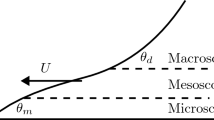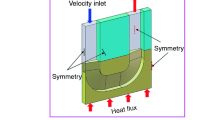Abstract
This paper analyzes a three-dimensional micromixer based on Koch fractal and split-and-recombination (SAR) channel through simulation and experiment. It is proved that the microchannel with Koch fractal structure can effectively increase the contact area of the fluid, the SAR cross channel can generate chaotic convection through irregular splitting, recombination and folding of fluid flow and is not particularly dependent on fluid inertia, so satisfactory mixing efficiency can be achieved even at low Reynolds number (Re). The simulation results show that when Re is 0.1, the mixing efficiency can reach 97.44%. Since the channels are interlaced with multiple layers, it is a challenging task to use conventional lithography or chemical etching, Therefore, CO2 laser system was used to process and manufacture a SAR micromixer with Koch fractal on a polymethyl methacrylate (PMMA) substrate. This study focuses on the effects of laser power and cutting times on the quality of microchannels in a CO2 laser system. Finally, 20 w CO2 laser power and 15 mm/s laser cutting speed were selected to cut the PMMA substrate for three times, and the micromixer was fabricated by combining the hot-pressing bonding technology.













Similar content being viewed by others
References
Ahmed D, Mao X, Shi J, Juluri BK, Huang TJ (2009) A millisecond micromixer via single-bubble-based acoustic streaming. Lab Chip 9(18):2738–2741
Akram N, Montazer E, Kazi SN, Soudagar MEM, Ahmed W, Zubir MNM, Sarsam WS (2021) Experimental investigations of the performance of a flat-plate solar collector using carbon and metal oxides based nanofluids. Energy. https://doi.org/10.1016/j.energy.2021.120452
Ali HM (2020) Recent advancements in PV cooling and efficiency enhancement integrating phase change materials based systems–A comprehensive review. Sol Energy 197:163–198
Ali HM, Jamil F, Babar H (2021) Thermal energy storage: storage techniques, advanced materials, thermophysical properties and applications. Springer Nature. https://doi.org/10.1007/978-981-16-1131-5
Alqahtani S, Ali HM, Farukh F, Silberschmidt VV, Kandan K (2021) Thermal performance of additively manufactured polymer lattices. J Build Eng 39:102243
Ansari MA, Kim KY, Anwar K, Kim SM (2010) A novel passive micromixer based on unbalanced splits and collisions of fluid streams. J Micromech Microeng. https://doi.org/10.1088/0960-1317/20/5/055007
Ashraf S, Sultan M, Bahrami M, McCague C, Shahzad MW, Amani M, Ali HM (2021) Recent progress on water vapor adsorption equilibrium by metal-organic frameworks for heat transformation applications. Int Commun Heat Mass Transfer 124:105242
Babar H, Ali HM (2019) Towards hybrid nanofluids: preparation, thermophysical properties, applications, and challenges. J Mol Liquids 281:598–633
Baek S, Kim J-M, Song S et al (2016) Nanoscale diameter control of sensory polydiacetylene nanoparticles on microfluidic chip for enhanced fluorescence signal. Sensors Act B Chem 230:623–629
Bayareh M, Ashani MN, Usefian A (2019) Active and passive micromixers: a comprehensive review. J Chem Eng Process 147:107771
Chen X, Li T (2016) A novel passive micromixer designed by applying an optimization algorithm to the zigzag microchannel. Chem Eng J 313:1406–1414
Chen X, Shen J (2017b) Simulation and experimental analysis of a sar micromixer with f-shape mixing units. Anal Methods 9(12):1885–1890
Chen X, Shen, & Jienan. (2017a) Numerical analysis of mixing behaviors of two types of e shape micromixers. Int J Heat Mass Transfer 106:593–600
Chen X, Zhao Z (2017) Numerical investigation on layout optimization of obstacles in a three-dimensional passive micromixer. Anal Chim Acta 964:142–149
Chen X, Shen J, Zhou M (2016a) Rapid fabrication of a four-layer PMMA-based microfluidic chip using CO2-laser micromachining and thermal bonding. J Micromech Microeng. https://doi.org/10.1088/0960-1317/26/10/107001/meta
Chen X, Li T, Shen J (2016b) CO2 laser ablation of microchannel on PMMA substrate for effective fabrication of microfluidic chips. Int Polym Proc 31(2):233–238
Dong X, Liu X (2021) Multi-objective optimization of heat transfer in microchannel for non-Newtonian fluid. Chem Eng J. https://doi.org/10.1016/j.cej.2021.128594
Ghodbane M, Boumeddane B, Hussein AK, Ali HM, Li D (2021) Thermal numerical investigation of a small parabolic trough collector under desert climatic conditions. J Therm Eng 7(3):429–446
Gidde RR, Pawar PM, Ronge BP et al (2018) Evaluation of the mixing performance in a planar passive micromixer with circular and square mixing chambers. Microsyst Technol 24(6):2599–2610
Gidde RR, Pawar PM, Ronge BP, Shinde AB, Misal ND, Wangikar SS (2019) Flow field analysis of a passive wavy micromixer with CSAR and ESAR elements. Microsyst Technol 25(3):1017–1030
Gutierrez L, Gomez L, Irusta S, Arruebo M, Santamaria J (2011) Comparative study of the synthesis of silica nanoparticles in micromixer–microreactor and batch reactor systems. Chem Eng J 171(2):674–683
Holvey CP, Roberge DM, Gottsponer M, Kockmann N, Macchi A (2011) Pressure drop and mixing in single phase microreactors: simplified designs of micromixers. Chem Eng Process 50(10):1069–1075
Huang CY, Wan SA, Hu YH (2017) Oxygen and nitrogen gases mixing in t-type micromixers visualized and quantitatively characterized using pressure-sensitive paint. Int J Heat Mass Transf 111:520–531
Ibrahim M, Saeed T, Chu YM, Ali HM, Cheraghian G, Kalbasi R (2021) Comprehensive study concerned graphene nano-sheets dispersed in ethylene glycol: Experimental study and theoretical prediction of thermal conductivity. Powder Technol 386:51–59
Jamil F, Ali HM, Nasir MA, Karahan M, Janjua MM, Naseer A, Pasha RA (2021a) Evaluation of photovoltaic panels using different nano phase change material and a concise comparison: An experimental study. Renewable Energy 169:1265–1279
Jamil F, Ali HM, Janjua MM (2021b) MXene based advanced materials for thermal energy storage: a recent review. J Energy Storage. https://doi.org/10.1016/j.est.2021.102322
Jing D, Yi S (2019) Electroosmotic flow in treelike branching microchannel network. Fractals 27(6):1950095
Lee CJ, Hsu YH (2019) Vacuum pouch microfluidic system and its application for thin-film micromixers. Lab Chip 19:2834
Li M, Wang J, Zhuang L, Chou SY (2000) Fabrication of circular optical structures with a 20 nm minimum feature size using nanoimprint lithography. Appl Phys Lett 76(6):673–675
Qureshi FA, Ahmad N, Ali HM (2021) Heat dissipation in bituminous asphalt catalyzed by different metallic oxide nanopowders. Construct Build Mater. https://doi.org/10.1016/j.conbuildmat.2020.122220
Su Y, Chen G, Kenig EY (2014) An experimental study on the numbering-up of microchannels for liquid mixing. Lab Chip 15(1):179–187
Usefian A, Bayareh M (2020) Numerical and experimental investigation of an efficient convergent-divergent micromixer. Meccanica. https://doi.org/10.1007/s11012-020-01142-0
Wang Y, Jiang Z, Chung B, Dutta P (2008) A rapid magnetic particle driven micromixer. Microfluid Nanofluid 4(5):375–389
Xiong S, Chen X (2021a) Numerical simulation of three-dimensional passive micromixer with variable-angle grooves and baffles. Surf Rev Lett (SRL) 28(05):1–8
Xiong S, Chen X (2021b) Numerical study of a three-dimensional electroosmotic micromixer with Koch fractal curve structure. J Chem Technol Biotechnol 96(7):1909–1917
Yin Z, Wang W (2019) Structure-induced method for circular cross-sectional nanochannel fabrication. J Nanosci Nanotechnol 19(9):5750–5754
Zhang S, Chen X, Wu Z, Zheng Y (2019) Numerical study on stagger Koch fractal baffles micromixer. Int J Heat Mass Transf 133:1065–1073
Zhou T, Ji X, Shi L, Zhang X, Sang WJ (2019) Ac dielectrophoretic deformable particle-particle interactions and their relative motions. Electrophoresis. https://doi.org/10.1002/elps.201900266
Acknowledgements
This work was supported by Young Taishan Scholars Program of Shandong Province of China (tsqn202103091), Shandong Provincial Natural Science Foundation (ZR2021JQ).
Author information
Authors and Affiliations
Corresponding author
Ethics declarations
Conflict of interest
The authors declare no conflict of interest.
Additional information
Publisher's Note
Springer Nature remains neutral with regard to jurisdictional claims in published maps and institutional affiliations.
Rights and permissions
About this article
Cite this article
Xiong, S., Chen, X. Simulation and experimental research of an effective SAR multilayer interlaced micromixer based on Koch fractal geometry. Microfluid Nanofluid 25, 92 (2021). https://doi.org/10.1007/s10404-021-02495-y
Received:
Accepted:
Published:
DOI: https://doi.org/10.1007/s10404-021-02495-y




